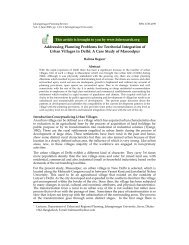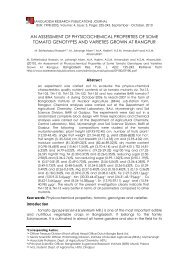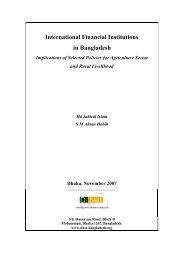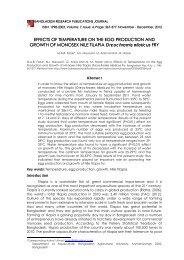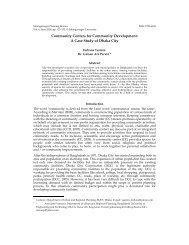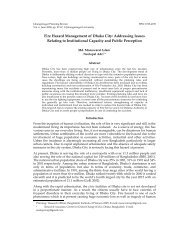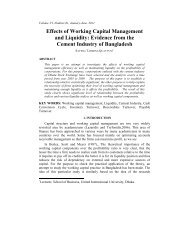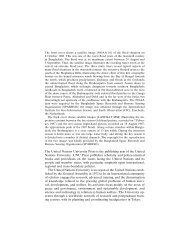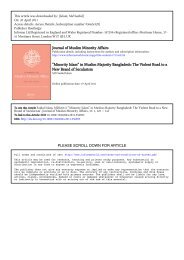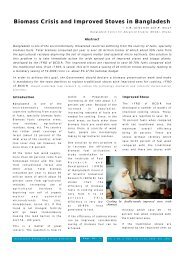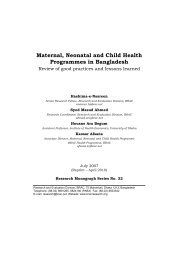Child Labour and Education in Bangladesh - Bangladesh Online ...
Child Labour and Education in Bangladesh - Bangladesh Online ...
Child Labour and Education in Bangladesh - Bangladesh Online ...
Create successful ePaper yourself
Turn your PDF publications into a flip-book with our unique Google optimized e-Paper software.
<strong>Bangladesh</strong> <strong>Education</strong> Journal 59b. <strong>Bangladesh</strong> Institute of <strong>Labour</strong> Study or BILS runs a Hazardous <strong>Child</strong> <strong>Labour</strong>Project funded by the Council of Denmark. The project is runn<strong>in</strong>g three non-formaleducational centres <strong>and</strong> technical tra<strong>in</strong><strong>in</strong>g service for child workers aged 12-14, <strong>in</strong>Gazipur, Keranigonj, Mirpur <strong>and</strong> Tongi. <strong>Child</strong> workers are provided with basiceducation, vocational tra<strong>in</strong><strong>in</strong>g <strong>and</strong> awareness tra<strong>in</strong><strong>in</strong>g on their rights before they enterthe labour market. The project also runs a Primary Health Care Service for tra<strong>in</strong>ees <strong>and</strong>students as well as a Motor Mechanic Workshop for <strong>in</strong>tensive tra<strong>in</strong><strong>in</strong>g on the trade to thegraduates of the centre.c. <strong>Child</strong> <strong>Labour</strong> Elim<strong>in</strong>ation Action Network or CLEAN is a regional network of 23NGOs funded by Manusher Jonno Foundation which was launched <strong>in</strong> 2003 to elim<strong>in</strong>atehazardous child work <strong>in</strong> 8 districts such as the stone field at Tetulia under Panchagarhdistrict. CLEAN engage <strong>in</strong> shar<strong>in</strong>g <strong>in</strong>formation, mobiliz<strong>in</strong>g local actors <strong>and</strong> liais<strong>in</strong>gwith local government <strong>in</strong> help<strong>in</strong>g to identify <strong>and</strong> elim<strong>in</strong>ate hazardous child work.d. Jo<strong>in</strong>t <strong>Child</strong> <strong>Labour</strong> Work<strong>in</strong>g Group or JCLWG formed <strong>in</strong> 1999 comprised of ILO,UNICEF, <strong>Bangladesh</strong> Shishu Adhikar Forum, Dhaka Ahsania Mission, Save the<strong>Child</strong>ren Alliance <strong>and</strong> Centre for Mass <strong>Education</strong> <strong>in</strong> Science. The JCLWG aims forbetter co-ord<strong>in</strong>ation <strong>and</strong> synergies amongst different child labour programme throughknowledge shar<strong>in</strong>g which <strong>in</strong>clude lessons learnt from various activities undertaken bygroup members. The JCLWG have also been work<strong>in</strong>g closely with government on theeffective implementation of the national TBP, with<strong>in</strong> the framework of the ILOconvention.The <strong>in</strong>itiatives mentioned are not an exhaustive account. They represent the types of effortsundertaken to address the problems of child labour <strong>in</strong>clud<strong>in</strong>g WFCL. They complement <strong>and</strong>supplement the measures needed to exp<strong>and</strong> <strong>and</strong> improve effective access <strong>and</strong> participation ofthe vulnerable groups <strong>in</strong> the ma<strong>in</strong> stream basic general education system as well as new <strong>and</strong>exp<strong>and</strong>ed opportunities for relevant vocational <strong>and</strong> occupational education <strong>and</strong> tra<strong>in</strong><strong>in</strong>g.VI. Conclusions <strong>and</strong> Recommendations<strong>Child</strong> labour <strong>and</strong> education are <strong>in</strong>extricably l<strong>in</strong>ked. <strong>Child</strong> labour impacts on the enrollmentrates, dropout <strong>and</strong> transition rates at the primary <strong>and</strong> secondary education level.Concomitantly, an <strong>in</strong>accessible <strong>and</strong> low-quality educational system <strong>in</strong>creases the <strong>in</strong>cidenceof child labour <strong>and</strong> thereby causes an even poorer quality of life for the most vulnerable <strong>in</strong>society.The decl<strong>in</strong>e <strong>in</strong> child labour rates <strong>and</strong> the <strong>in</strong>crease <strong>in</strong> Gross Enrollment Rates <strong>and</strong> NetEnrollment Rates over the last 10 years or so have been promis<strong>in</strong>g. The work that has beendone by key stakeholders such as the M<strong>in</strong>istry of <strong>Labour</strong> <strong>and</strong> Employment, M<strong>in</strong>istry ofPrimary <strong>and</strong> Mass <strong>Education</strong> <strong>and</strong> other relevant m<strong>in</strong>istries, ILO-IPEC, UNICEF, UNESCO,Schools, NGOS, <strong>and</strong> Private Sector has shown positive results <strong>in</strong> awareness-rais<strong>in</strong>g, socialmobilization, strengthen<strong>in</strong>g <strong>in</strong>stitutional capacity <strong>and</strong> commitment to mov<strong>in</strong>g towards thetw<strong>in</strong> goal of elim<strong>in</strong>at<strong>in</strong>g child labour <strong>and</strong> achiev<strong>in</strong>g education for all.



